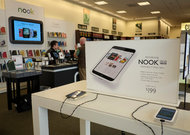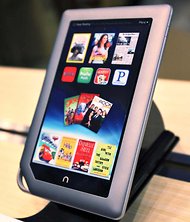Now the novel is dividing the nation’s booksellers with dueling paperback editions: the enigmatic blue cover of the original and the movie tie-in book that went on sale Tuesday, a brash, flashy version with Leonardo DiCaprio front and center.
The new edition is timed with the 3-D film adaptation, directed by Baz Luhrmann and starring Mr. DiCaprio, that will arrive in theaters on May 10.
So far this year, sales of the paperback with the original jacket art — a glowing cityscape and a pair of floating eyes — have been extraordinary. On Thursday, it was the top-selling book on Amazon.com. At Barnes Noble stores last week, no other paperback book sold more copies. It has landed on best-seller lists for independent bookstores.
The new edition, with its Art Deco glitter, presents a stark choice for readers, as well as retailers who are trying to gauge the tastes of their customers.
At stores like Barnes Noble, with its nearly 700 outlets, both editions will be available. But at Walmart, only the movie tie-in edition will be stocked, a tacit acknowledgment that the discount chain’s customers want books that appear fresh and new (even if they happen to have been released in 1925). And at independent booksellers like McNally Jackson in SoHo, customers who want “The Great Gatsby” can purchase only the original: not a single copy of the new, cinematic edition will be for sale.
“It’s just God-awful,” Kevin Cassem, a bookseller at McNally Jackson, said on Tuesday. “ ‘The Great Gatsby’ is a pillar of American literature, and people don’t want it messed with. We’re selling the classic cover and have no intention of selling the new one.”
Movie tie-in editions are issued regularly in the book business, but rarely has the contrast between two covers of the same title been so pronounced.
The original art, by Francis Cugat, was completed before the manuscript, according to Scribner, a practice that is common in modern publishing but was rare at the time. The art was initially dismissed as “garish” by Ernest Hemingway, who wrote in his memoir “A Moveable Feast” that he was “embarrassed by the violence, bad taste and slippery look of it.”
“It looked the book jacket for a book of bad science fiction,” Hemingway wrote.
F. Scott Fitzgerald, he wrote, told him “not to be put off by it, that it had to do with a billboard along a highway in Long Island that was important in the story.” (Close readers of the book will also see a visual parallel in the narrator Nick Carraway’s reference to the “girl whose disembodied face floated along the dark cornices and blinding signs.”)
While “Gatsby” has been subject to dozens of cover redesigns — and translated into 42 languages, producing covers that read “El Gran Gatsby” and “Gatsby le Magnifique” — it is the original cover that Scribner has kept in print.
Scribner, an imprint of Simon Schuster, typically sells 500,000 copies each year, but in 2013 it has already shipped 280,000 copies, according to the publisher.
E-book sales have been skyrocketing, too: in 2012, about 80,000 e-book copies of “Gatsby” were sold. So far this year, sales have surpassed 125,000.
Those numbers suggest that “The Great Gatsby,” frequently described as the greatest American novel ever, will be among the top-selling books of 2013, a literary palate cleanser to follow 2012, when the American book-buying public gorged on the “Fifty Shades” erotica series.
But Scribner also has high expectations for the movie tie-in edition: it is printing more than 350,000 copies.
The tie-in edition is likely to appeal to “the new reader,” said Nan Graham, the publisher of Scribner.
“The repeat reader is going to buy the classic cover,” she said in an interview. “A person who is more likely to buy the movie tie-in is reading it for the first time. In Walmart, this is the book you’re going to see.”
Cathy Langer, the lead book buyer at the Tattered Cover in Denver, said that by issuing two covers, publishers are trying to reach two audiences that may not overlap.
“It really depends who you are — if you think it’s cool to have the movie star on the cover, then that’s what you’ll buy,” she said. “The more readers a publisher can bring to a book, the better it is for everyone.”
Sales history for movie tie-in editions of novels has been mixed. Original covers typically outperform tie-ins because they are on sale longer and because many consumers are reluctant to make a book purchase that appears to be inspired by the local multiplex.
When both editions of “Eat, Pray, Love” by Elizabeth Gilbert were displayed side by side in bookstores in 2010, the original paperback won out over the movie tie-in, which featured a picture of Julia Roberts eating gelato on a park bench.
“I think the great thing is that there are some people who are reading all the time, and there are people who only read selectively,” said Patrick Nolan, editor in chief and associate publisher of Penguin Books, which released “Eat, Pray, Love,” “but the books work on both kinds of readers.”
One exception was “Revolutionary Road” by Richard Yates, a novel originally published in 1961 that only began attracting hordes of readers — eventually selling 700,000 copies — when the movie tie-in edition was released in 2008 (with Kate Winslet and Mr. DiCaprio on the cover).
Anne Messitte, executive vice president of Knopf Doubleday, part of Random House, said publishers were trying to reach readers who might be more tuned into what was happening in Hollywood than what was on the best-seller lists. (They may also have discovered the book through the “Gatsby”-themed merchandise showing up at retailers like Tiffany and Brooks Brothers.)
“As publishers we’re always looking for new readers, and the transformation of a book into a film can exponentially increase consumer awareness,” she said. “It begins with early press coverage of casting and shooting, and continues through to the film’s prerelease marketing campaign and theatrical run.”
As to whether the new, DiCaprio-ed edition of “Gatsby” would be socially acceptable to carry around in public, Mr. Cassem of McNally Jackson offered a firm no. “I think it would bring shame,” he said, “to anyone who was trying to read that book on the subway.”
Article source: http://www.nytimes.com/2013/04/26/business/media/new-great-gatsby-book-carries-a-hollywood-look.html?partner=rss&emc=rss

